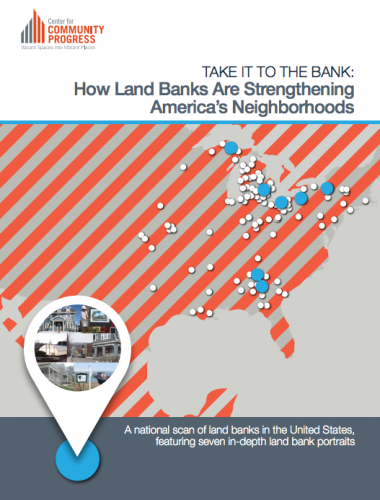For those who work on combating growing numbers of problem properties, and who are looking to expand the available toolbox of options, the buzz these days is all about land banks.
What are land banks? in this report, land banks are defined as governmental entities or special purpose nonprofit corporations that specialize in the acquisition of problem properties, with the intention of either immediately returning these properties to productive use, or temporarily holding and maintaining them for the purpose of stabilizing distressed markets or fulfilling long-term land use and community goals.
In short, land banks acquire title to problem properties, eliminate the liabilities, and transfer the properties to new, responsible owners in a transparent and efficient manner that supports community-based plans.
The adaptability of land banks to meet a variety of critical community needs has generated a tremendous level of interest in land banking as a tool, but Community Progress’ experience reveals a common misunderstanding about the ease of creating a land bank. Generally speaking, most local governments do not have the legal authority to create a land bank that is endowed with the specific legal powers needed to make it an effective tool for addressing vacancy and abandonment.
Local and state legal frameworks largely shape and constrain a community’s options when trying to implement new systemic responses to vacancy and abandonment—and that goes for more than just land banking. Some local jurisdictions may have wide latitude and the legal powers to implement new code enforcement regulations, for example, but jurisdictions in other states looking to implement the same reform or policy may be restrained by state laws. What may be a barrier to an efficient tax foreclosure process in one state could very well be a non-issue in another, because tax foreclosure laws differ significantly from state to state. The social, financial, and cultural costs of vacancy and abandonment may be similar across regions, but because of unique local and state legal frameworks, the most effective approaches to combating vacancy and abandonment can vary widely.
This report depicts the local conditions, actors, and narratives that together comprise the national story of land banks. However, due to variations in state and local legal frameworks (described in greater detail in Section One), the movements in Michigan, Ohio, Georgia, New York, and elsewhere that together make up this national story are each worthy of more detailed description than can be addressed within the scope of this report. Nevertheless, the authors hope this report is of use to both practitioners and others with an interest or role in land banking in the United States.
Read the report
Six key takeaways
Table of Contents
| Foreword | |||
| Introduction | The National Land Bank Movement: 40 Years and Counting | ||
| Section Two | National Scan : A Surging and Diverse Land Bank Movement | ||
| A. Three Generations of Land Banks | |||
| B. Diverse, Widespread, But a Lot in Common | |||
| 1. Commonality #1: Acquisition strategies | |||
| 2. Commonality #2: Holding and maintaining property | |||
| 3. Commonality #3: Disposition of property | |||
| 4. Commonality #4: Community engagement | |||
| 5. Commonality #5: Data tracking and property portfolio management | |||
| 6. Commonality #6: Statewide networks | |||
| 7. Commonality #7: Challenges | |||
| Section Three | Meet the Land Banks: Seven Portraits | ||
| 1. Genesee County Land Bank Authority (Michigan) | |||
| 2. Cuyahoga County Land Reutilization Corporation (Ohio) | |||
| 3. Greater Syracuse Land Bank (New York) | |||
| 4. Fulton County/City of Atlanta Land Bank Authority (Georgia) | |||
| 5. Macon-Bibb County Land Bank Authority (Georgia) | |||
| 6. Marquette County Land Bank Authority (Michigan) | |||
| 7. Chautauqua County Land Bank Corporation (New York) | |||
| Conclusion | Land Banks: Strengthening America’s Neighborhoods | ||
| Appendices | Genesee County Land Bank Authority | ||
| A. Revenue and Expenses Chart | |||
| B. Organizational Chart | |||
| C. Residential Property Interest Application | |||
| D. Commercial Property Interest Application | |||
| F. Citizen’s Advisory Council Roles and Responsibilities | |||
| E. Clean and Green Application Form | |||
| Cuyahoga County Land Reutilization Corporation | |||
| G. Revenue and Expenses Chart | |||
| H. Property Purchaser Application | |||
| I. Owner Occupier Advantage Program Description | |||
| J. Nonprofit Program Proposal Form | |||
| Greater Syracuse Land Bank Authority | |||
| K. Revenue and Expenses Chart | |||
| L. Draft 2014 – 2017 Budget | |||
| M. Property Purchase Application | |||
| Fulton County/City of Atlanta Land Bank Authority | |||
| N. Revenue and Expenses Chart | |||
| O. Land Banking Program Policies and Procedures | |||
| Macon-Bibb County Land Bank Authority | |||
| P. Revenue and Expenses Chart | |||
| Marquette County Land Bank Authority | |||
| Q. Revenue and Expenses Chart | |||
| R. 2013 Annual Report | |||
| Chautauqua County Land Bank Corporations | |||
| S. Revenue and Expenses Chart | |||





